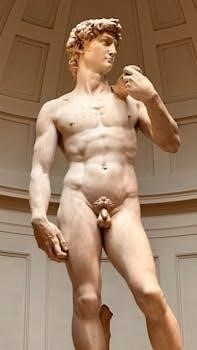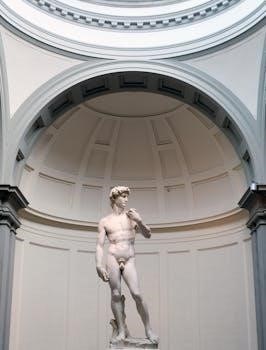
This section introduces Michael Joyce, a tennis player, and David Foster Wallace, a writer. Their connection stems from Wallace’s 1996 essay profiling Joyce. This essay is a key element in understanding their interaction and impact.
Overview of the Relationship Between Joyce and Wallace
The relationship between Michael Joyce and David Foster Wallace is primarily defined by Wallace’s in-depth profile of Joyce, originally titled “The String Theory,” later republished in collections. Wallace observed Joyce’s disciplined approach to tennis, using him as a lens to explore themes of choice, freedom, and human completeness. This interaction was through Wallace’s journalistic and literary lens, not as a personal friendship. The essay serves as the core of their connection.

David Foster Wallace’s Essay “The String Theory”
This section focuses on David Foster Wallace’s essay, “The String Theory,” a profile of Michael Joyce. The essay, originally published in Esquire, is a significant piece of sports writing.
Original Publication and Title
David Foster Wallace’s essay on Michael Joyce was initially published in Esquire magazine in 1996. The original title of the piece was “The String Theory,” a title that later became associated with a collection of Wallace’s essays. This title reflects the complex and interwoven nature of the essay’s themes, hinting at the underlying structure and tension explored within the narrative. The piece has since been republished in other collections under the same name.
Thematic Focus of the Essay
Wallace’s essay, “The String Theory,” delves into the professional artistry of tennis player Michael Joyce. The essay examines themes of choice, freedom, limitation, joy, and the grotesque. It explores the disciplined life of a professional athlete and what it means to strive for human completeness through sport. The piece is not just about tennis, but uses the sport as a lens to examine broader existential questions, looking at the nature of human ambition and the pursuit of perfection.

Michael Joyce’s Tennis Career
Michael Joyce was a professional tennis player active in the 1990s. He reached a peak ranking of 64th in the world. His career is closely linked to Wallace’s essay.
Joyce’s Professional Ranking and Achievements
Michael Joyce achieved a career-high ranking of 64 on the ATP tour. While not a top-ten player, his dedication and discipline were notable. He competed in various tournaments, showcasing a strong work ethic. His achievements, though modest compared to tennis legends, provided the backdrop for David Foster Wallace’s insightful essay. Joyce’s climb through the ranks was a testament to his commitment and focus, despite not attaining superstar status.
Physical Description and Playing Style
Michael Joyce was described as being around five foot nine inches tall, and 165 pounds, though some sources list him as five eleven. His playing style was characterized by supreme discipline and a tireless work ethic. He was not known for overwhelming power but for strategic consistency. Joyce’s game focused on precise shot placement and relentless effort. His focused demeanor on the court was a key aspect of his image, as highlighted by Wallace.

Joyce’s Post-Playing Career
After his tennis career, Michael Joyce transitioned into coaching; He notably coached Maria Sharapova from 2004 to 2011. This coaching role marked a significant phase after his playing days.
Coaching Maria Sharapova
Michael Joyce’s most prominent post-playing role was coaching Maria Sharapova. He began this partnership in the summer of 2004, working alongside her father, Yuri Sharapov. Joyce remained Sharapova’s coach until January 2011, when he was replaced. This period represents a significant chapter in his coaching career, during which he contributed to her development and success on the professional tennis circuit. His tenure saw Sharapova achieve notable milestones.
Life After Coaching
Following his departure from coaching Maria Sharapova in 2011, details about Michael Joyce’s life are less prominent in public sources. Information about his subsequent career moves or personal endeavors is not widely documented in the provided text. This makes it difficult to accurately describe his activities after ending his coaching partnership with Sharapova. Further research beyond the available information would be needed for a full picture of his post-coaching life.
Reactions to Wallace’s Essay
Wallace’s essay on Michael Joyce is celebrated as an exceptional piece of sports writing. It gained significant critical acclaim for its unique approach and insightful analysis of a tennis player.
Critical Acclaim and Impact
David Foster Wallace’s essay on Michael Joyce, initially titled “The String Theory,” garnered widespread critical acclaim and is considered a landmark in sports writing. The essay’s impact stems from Wallace’s distinctive literary style and deep exploration of themes beyond the sport itself. Its republication in collections further cemented its status as a significant work, showcasing Wallace’s ability to find profound meaning in seemingly ordinary subjects, making it a highly influential piece.
Joyce’s Perspective on the Essay
Michael Joyce, the subject of Wallace’s essay, has had the unique experience of being both observed and analyzed through Wallace’s literary lens. While specific details of his direct public response to the essay are not widely documented, it is understood that he eventually was able to scrutinize Wallace as well; This creates an interesting dynamic where the subject becomes a reader of his own portrayal, offering a different perspective on the piece.
Analysis of Key Themes in the Essay
Wallace’s essay explores themes of choice, freedom, and limitation within the context of Joyce’s tennis career. It also delves into artistry, discipline, and the idea of human completeness.
Choice, Freedom, and Limitation
Wallace’s essay intricately examines the perceived choices of a professional tennis player, questioning the extent of true freedom within the rigid structure of the sport. The limitations imposed by physical capabilities, training regimes, and the competitive environment are explored. Joyce’s dedication highlights the constraints within the perceived freedom of his chosen career path. The essay prompts consideration of how much control an athlete truly has.
Artistry, Discipline, and Human Completeness
The essay delves into the artistic aspects of tennis, portraying Michael Joyce’s disciplined approach as a form of artistry. Wallace contemplates whether such intense dedication leads to a form of “human completeness”. He explores the balance between rigorous training and the broader aspects of life. The essay examines the sacrifices made in pursuit of athletic excellence and their impact on an individual’s overall development.

The Significance of the Essay
This essay significantly contributed to sports writing by offering a deep, literary analysis of an athlete’s life. Wallace’s unique style brought a new perspective to the genre and its impact is still felt today.
Contribution to Sports Writing
Wallace’s essay, “The String Theory,” transcends typical sports journalism by employing profound literary techniques. It delves into the psychological and philosophical aspects of athletic discipline, moving beyond simple game analysis. This approach elevated sports writing, treating athletes as subjects worthy of complex, nuanced exploration. Wallace’s work influenced a new generation of writers to seek deeper meaning within sports narratives, moving past the typical recounting of scores and statistics to analyze the human condition.
Wallace’s Unique Style and Perspective
David Foster Wallace’s distinctive style in “The String Theory” is marked by his use of extensive footnotes and digressions, creating a complex narrative. His perspective blends meticulous observation with philosophical musings on choice, freedom, and limitation. Wallace uniquely examines Joyce’s disciplined artistry, seeing it as a microcosm of broader human experience. This approach is both deeply personal and intellectually rigorous, setting his writing apart from traditional sports journalism, and making it a thought-provoking and memorable experience.
The Legacy of Michael Joyce and David Foster Wallace
Their combined legacy impacts both tennis and literature. Wallace’s essay brought a unique perspective to sports writing. Joyce’s career provides a real-world example of Wallace’s themes.
Impact on Tennis and Literature
David Foster Wallace’s essay significantly impacted sports literature by bringing an in-depth, literary analysis to the world of professional tennis. It elevated sports writing beyond simple reporting, exploring themes of artistry, discipline, and human limitation. Michael Joyce, as the subject, represents a real-life example of these concepts, bridging the gap between athletic endeavor and intellectual exploration. This pairing influenced how both fields are perceived.
Remembering Wallace and the Essay
David Foster Wallace’s legacy as a writer is firmly linked to his insightful essays, particularly “The String Theory.” Remembering Wallace means revisiting his unique style and perspective on sports and life. The essay, profiling Michael Joyce, is often recalled as a prime example of his ability to find profound meaning in everyday experiences. Wallace’s work continues to be celebrated and re-examined today, ensuring his place in literature.
Recent Discussion and Rediscovery of the Essay
There’s been a recent resurgence of interest in Wallace’s essay on Michael Joyce. This rediscovery includes new discussions, podcasts, and renewed critical analysis, highlighting its lasting impact.
Anniversary and New Interest
The passage of time, particularly anniversaries related to the essay’s original publication, has sparked a significant resurgence of interest. This renewed attention is evident in both literary and sports circles. The unique perspective offered by Wallace, combined with Joyce’s compelling story, has drawn in a new generation of readers and critics. This has led to a fresh wave of conversations and analyses, further solidifying the essay’s importance in both sports writing and contemporary literature.
Podcast Discussions of the Essay
The essay “The String Theory,” featuring Michael Joyce, has recently become a popular topic in various podcast discussions. These podcasts delve into the complexities of the essay, exploring both Wallace’s writing style and the themes presented. They often analyze the dynamics between artistry and discipline, drawing parallels to both sport and life. The accessibility of podcasts has introduced Wallace’s work to a wider audience, sparking new conversations about the essay’s impact.
